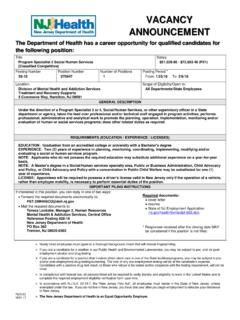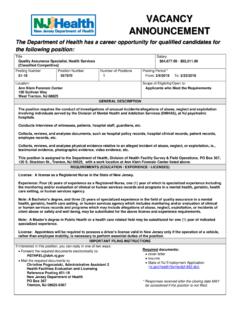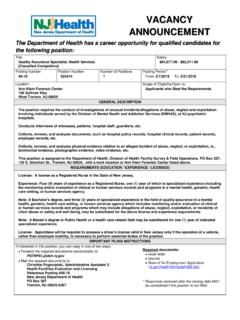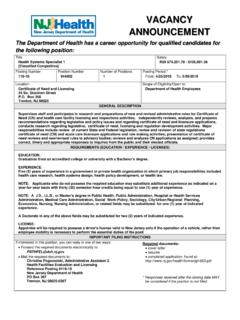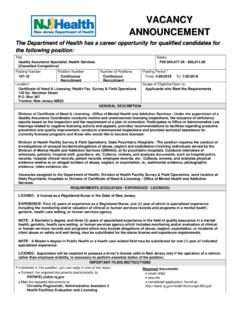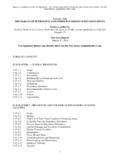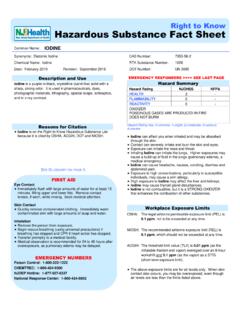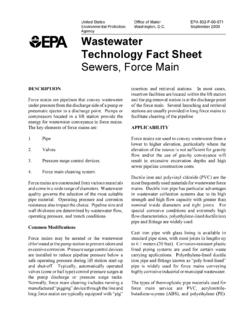Transcription of SILICON CARBIDE HAZARD SUMMARY WORKPLACE …
1 Common Name: SILICON CARBIDE CAS Number: 409-21-2 DOT Number: None DOT HAZARD Class: None ---------------------------------------- ----------------------------------- HAZARD SUMMARY * SILICON CARBIDE can affect you when breathed in. * SILICON CARBIDE can irritate the eyes and nose on contact. * Repeated high exposure to SILICON CARBIDE may result in Pneumoconiosis (chronic disease of the lungs) with chest x-ray changes, and a decrease in lung function with shortness of breath, wheezing and cough. * If Pneumoconiosis develops, chances of getting Tuberculosis are increased. IDENTIFICATION SILICON CARBIDE is a crystalline (sand-like) material which varies in color from clear to pale yellow or from green to black. It is used in pencils, sandpaper, ceramics, and abrasive grinding wheels, and as refractory material.
2 REASON FOR CITATION * SILICON CARBIDE is on the Hazardous Substance List because it is regulated by OSHA and cited by ACGIH and NIOSH. * Definitions are provided on page 5. HOW TO DETERMINE IF YOU ARE BEING EXPOSED The New Jersey Right to Know Act requires most employers to label chemicals in the WORKPLACE and requires public employers to provide their employees with information and training concerning chemical hazards and controls. The federal OSHA HAZARD Communication Standard (29 CFR ) requires private employers to provide similar training and information to their employees. * Exposure to hazardous substances should be routinely evaluated. This may include collecting personal and area air samples. You can obtain copies of sampling results from your employer.
3 You have a legal right to this information under the OSHA Access to Employee Exposure and Medical Records Standard (29 CFR ). * If you think you are experiencing any work-related health problems, see a doctor trained to recognize occupational diseases. Take this Fact Sheet with you. RTK Substance number: 1658 Date: April 2002 Revision: February 2007 ---------------------------------------- ----------------------------------- WORKPLACE EXPOSURE LIMITS OSHA: The legal airborne permissible exposure limit (PEL) is 15 mg/m3 as total dust and 5 mg/m3 as respirable dust over an 8-hour workshift. NIOSH: The recommended airborne exposure limit is 10 mg/m3 as total dust and 5 mg/m3 as respirable dust over a 10-hour workshift.
4 ACGIH: The recommended airborne exposure limit is 10 mg/m3 as the inhalable fraction, 3 mg/m3 as the respirable fraction for nonfibrous SILICON CARBIDE containing no asbestos and less than 1% Crystalline Silica and f/cc (fibers per cubic centimeter) for the fibrous form averaged over an 8-hour workshift. WAYS OF REDUCING EXPOSURE * Where possible, enclose operations and use local exhaust ventilation at the site of chemical release. If local exhaust ventilation or enclosure is not used, respirators should be worn. * Wear protective work clothing. * Wash thoroughly immediately after exposure to SILICON CARBIDE and at the end of the workshift. * Post HAZARD and warning information in the work area. In addition, as part of an ongoing education and training effort, communicate all information on the health and safety hazards of SILICON CARBIDE to potentially exposed workers.
5 SILICON CARBIDE page 2 of 6 This Fact Sheet is a SUMMARY source of information of all potential and most severe health hazards that may result from exposure. Duration of exposure, concentration of the substance and other factors will affect your susceptibility to any of the potential effects described below. ---------------------------------------- ------------------------------------- HEALTH HAZARD INFORMATION Acute Health Effects The following acute (short-term) health effects may occur immediately or shortly after exposure to SILICON CARBIDE : * SILICON CARBIDE can irritate the eyes and nose on contact.
6 Chronic Health Effects The following chronic (long-term) health effects can occur at some time after exposure to SILICON CARBIDE and can last for months or years: Cancer HAZARD * There is limited evidence that SILICON CARBIDE causes cancer in animals. It may cause cancer of the lungs. * Many scientists believe there is no safe level of exposure to a carcinogen. Such substances may also have the potential for causing reproductive damage in humans. Reproductive HAZARD * According to the information presently available to the New Jersey Department of Health and Senior Services, SILICON CARBIDE has not been tested for its ability to affect reproduction. Other Long-Term Effects * Repeated high exposure to SILICON CARBIDE may result in Pneumoconiosis (chronic disease of the lungs) with chest x-ray changes, and a decrease in lung function with shortness of breath, wheezing and cough.
7 * If Pneumoconiosis develops, chances of getting Tuberculosis are increased. MEDICAL Medical Testing Before beginning employment and at regular times after that, for those with frequent or potentially high exposures, the following are recommended: * Lung function tests * Skin test for Tuberculosis * Chest x-ray every one to three years Any evaluation should include a careful history of past and present symptoms with an exam. Medical tests that look for damage already done are not a substitute for controlling exposure. Request copies of your medical testing. You have a legal right to this information under the OSHA Access to Employee Exposure and Medical Records Standard (29 CFR ). Mixed Exposures * Because smoking can cause heart disease, as well as lung cancer, emphysema, and other respiratory problems, it may worsen respiratory conditions caused by chemical exposure.
8 Even if you have smoked for a long time, stopping now will reduce your risk of developing health problems. WORKPLACE CONTROLS AND PRACTICES Unless a less toxic chemical can be substituted for a hazardous substance, ENGINEERING CONTROLS are the most effective way of reducing exposure. The best protection is to enclose operations and/or provide local exhaust ventilation at the site of chemical release. Isolating operations can also reduce exposure. Using respirators or protective equipment is less effective than the controls mentioned above, but is sometimes necessary. In evaluating the controls present in your WORKPLACE , consider: (1) how hazardous the substance is, (2) how much of the substance is released into the WORKPLACE and (3) whether harmful skin or eye contact could occur.
9 Special controls should be in place for highly toxic chemicals or when significant skin, eye, or breathing exposures are possible. In addition, the following controls are recommended: * Where possible, automatically transfer SILICON CARBIDE from drums or other storage containers to process containers. * Work surfaces should be cleaned thoroughly on a routine basis. Good WORK PRACTICES can help to reduce hazardous exposures. The following work practices are recommended: * Workers whose clothing has been contaminated by SILICON CARBIDE should change into clean clothing promptly. * Do not take contaminated work clothes home. Family members could be exposed. * Contaminated work clothes should be laundered by individuals who have been informed of the hazards of exposure to SILICON CARBIDE .
10 * Eye wash fountains should be provided in the immediate work area for emergency use. * If there is the possibility of skin exposure, emergency shower facilities should be provided. * On skin contact with SILICON CARBIDE , immediately wash or shower to remove the chemical. At the end of the workshift, wash any areas of the body that may have contacted SILICON CARBIDE , whether or not known skin contact has occurred. * Do not eat, smoke, or drink where SILICON CARBIDE is handled, processed, or stored, since the chemical can be swallowed. Wash hands carefully before eating, drinking, applying cosmetics, smoking, or using the toilet. SILICON CARBIDE page 3 of 6 * Use a vacuum or a wet method to reduce dust during clean-up.
